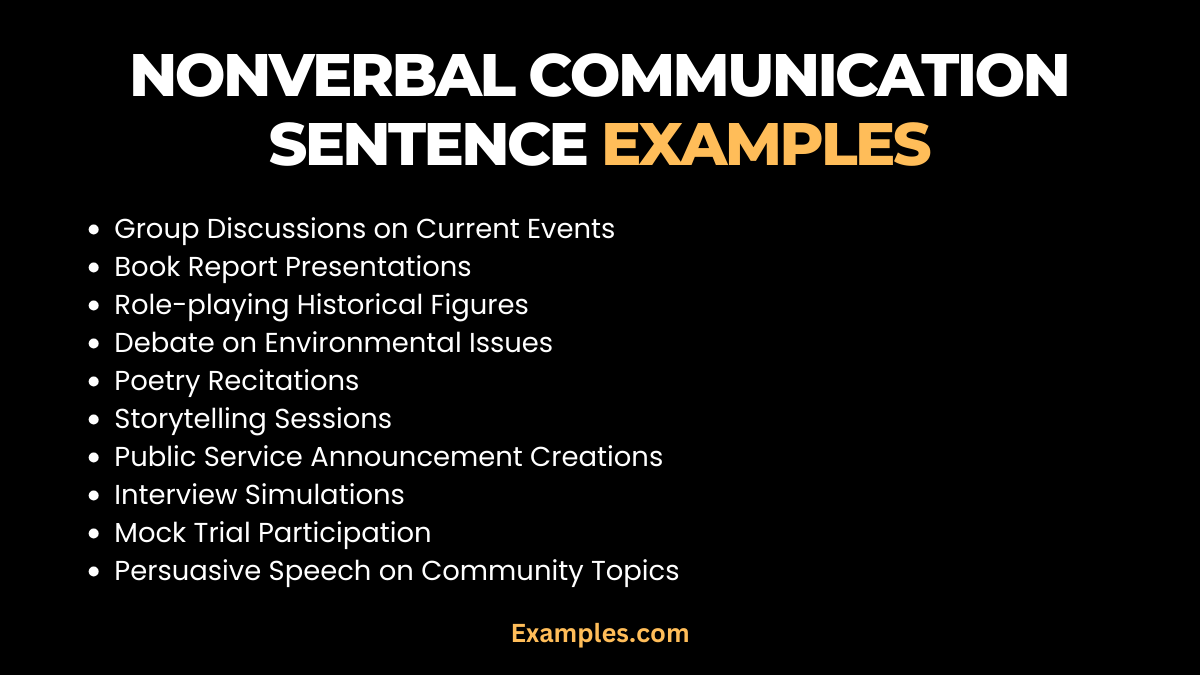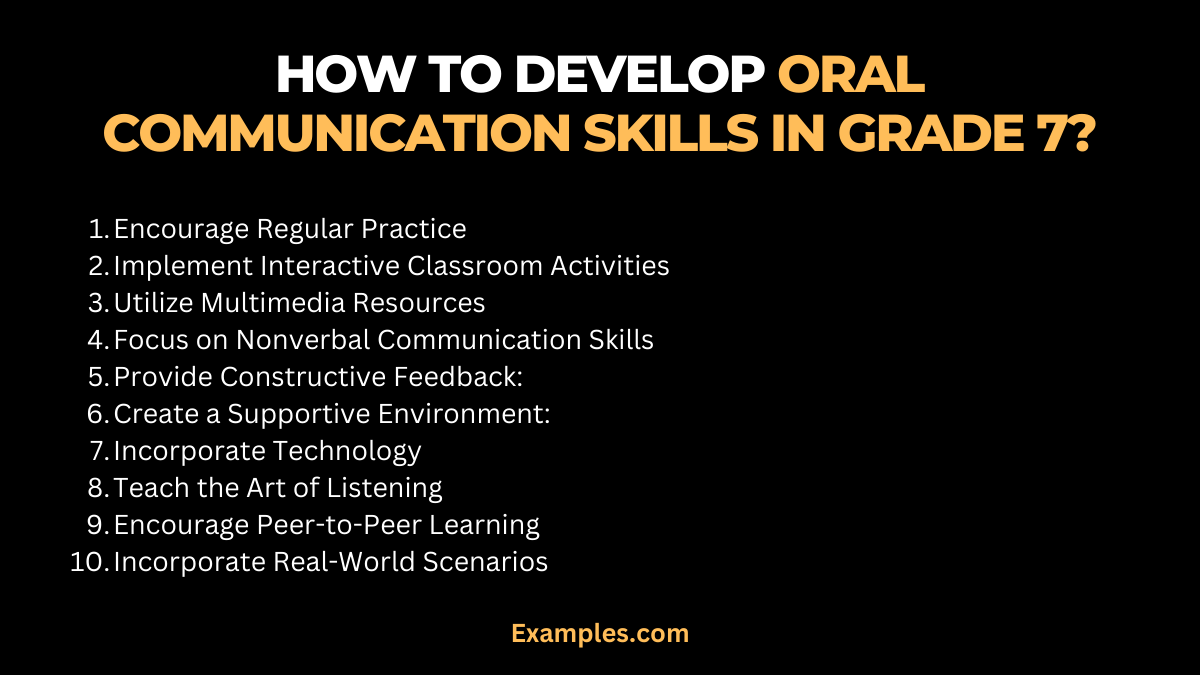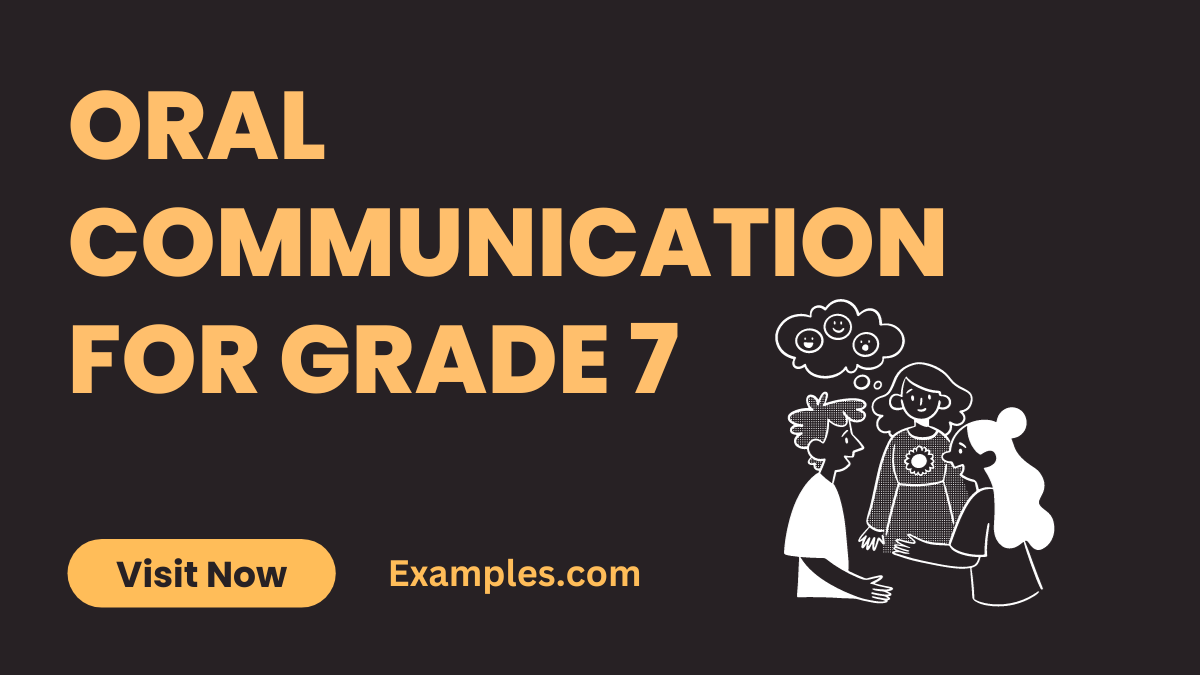29+ Oral Communication for Grade 7 Examples
Oral Communication for Grade 7 is a critical skill that shapes the way students interact and express themselves. This comprehensive guide delves into practical Communication Examples tailored for seventh graders, enhancing their ability to convey ideas effectively. From classroom discussions to presentations, this guide offers invaluable insights into developing adept speakers who can navigate various communication scenarios with confidence and clarity.
What is Oral Communication for Grade 7?

Oral Communication for Grade 7 refers to the verbal expression of ideas and information by students in the seventh grade. It’s a vital component of their educational development, encompassing everything from participating in class discussions to giving presentations. This form of communication not only aids in academic growth but also plays a significant role in developing interpersonal skills and self-confidence among young learners.
What is the Best Example of Oral Communication for Grade 7?
A quintessential example of oral communication for Grade 7 is a classroom presentation. This involves a student preparing a topic, organizing their thoughts, and verbally presenting the information to their peers and teacher. Such presentations are instrumental in enhancing public speaking skills, fostering critical thinking, and encouraging the effective organization of ideas. They offer a practical, engaging way for students to develop and demonstrate their oral communication skills in a supportive educational environment.
30 Oral Communication for Grade 7 Examples

Oral communication in Grade 7 encompasses a variety of activities designed to bolster students’ verbal expression and listening skills. These examples, rich in Oral Communication strategies, enhance students’ ability to articulate thoughts clearly and listen actively. By engaging in these diverse exercises, seventh graders develop a robust foundation in Effective Communication, preparing them for academic and personal success.
- Group Discussions on Current Events: Students discuss a current news topic, learning to express opinions and listen to others.
Example: “I believe that renewable energy is important because…” - Book Report Presentations: Each student presents a summary and review of a book they’ve read.
Example: “This book was intriguing because it showed…” - Role-playing Historical Figures: Students embody historical characters, enhancing understanding and speaking skills.
Example: “As Abraham Lincoln, I would have prioritized…” - Debate on Environmental Issues: Engaging in debates teaches argument formulation and rebuttal skills.
Example: “My stance on plastic usage is…” - Poetry Recitations: Reciting poems improves memory and expressive language skills.
Example: “This poem resonates with me because…” - Storytelling Sessions: Creating and telling stories boosts imagination and narrative skills. Example: “Once upon a time, in a land far away…”
- Public Service Announcement Creations: Crafting PSAs develops persuasive speaking and social awareness.
Example: “I want to raise awareness about…” - Interview Simulations: Practicing interviews hones question-response skills. Example: “My greatest strength is…”
- Mock Trial Participation: Involvement in mock trials enhances critical thinking and argument delivery.
Example: “As a defense attorney, I argue that…” - Persuasive Speech on Community Topics: Giving speeches on local issues develops persuasion and research skills.
Example: “I believe our community should…” - Science Experiment Explanations: Describing experiments teaches clarity and descriptive skills.
Example: “In this experiment, we observed…” - Classroom Newscast: Reporting class news develops reporting skills and confidence.
Example: “Today’s top story is about…” - Dramatic Monologues: Performing monologues improves emotional expression and public speaking.
Example: “In this scene, my character feels…” - Oral Book Reviews: Sharing book opinions encourages critical thinking and expression. Example: “What I liked about this book is…”
- Language Learning Conversations: Practicing a new language fosters communication and cultural understanding.
Example: “En español, me gusta hablar de…” - Giving Directions Exercise: Students practice giving clear and concise directions. Example: “To find the library, you need to…”
- Socratic Seminars: Participating in discussions fosters analytical thinking and respectful dialogue.
Example: “Socrates might argue that…” - Explaining Math Problems: Talking through math solutions develops explanatory and logical skills.
Example: “To solve this equation, first we…” - Cultural Exchange Presentations: Sharing about different cultures enhances global awareness and respect.
Example: “In Japanese culture, an important tradition is…” - Biography Speeches: Speaking about a significant person’s life encourages research and storytelling.
Example: “Nelson Mandela was important because…” - Giving Instructions for a Game: Explaining game rules refines clarity and instructional skills. Example: “To play this game, you must…”
- Peer Teaching Sessions: Teaching a concept to classmates enhances understanding and communication.
Example: “To understand photosynthesis, remember that…” - Talking About Personal Experiences: Sharing personal stories develops empathy and self-expression.
Example: “A challenging moment for me was when…” - Explaining Artwork: Discussing the meaning behind art pieces fosters interpretation and descriptive skills.
Example: “This painting represents…” - Community Issue Forum: Discussing local issues encourages civic engagement and speech skills.
Example: “A pressing issue in our community is…” - Creating How-To Guides: Writing and explaining guides develops instructional and technical language.
Example: “To create a birdhouse, first…” - Expressing Future Goals: Talking about future aspirations enhances goal-setting and motivational speaking.
Example: “My dream job is to be…” - Health and Wellness Presentations: Educating peers about health topics promotes research and public speaking.
Example: “A healthy lifestyle includes…” - Technology Usage Discussions: Debating technology’s role in life cultivates analytical and persuasive speaking.
Example: “Technology impacts education by…” - Environmental Conservation Speeches: Advocating for environmental issues develops passion.
Grade 7 Oral Communication Activities
These activities, tailored for seventh graders, focus on interactive and creative exercises that foster Effective Communication and Assertive Communication in young learners. From impromptu speaking to group discussions, these activities are designed to be both educational and enjoyable.
- Impromptu Speaking Challenges: Students speak on a topic with little preparation, enhancing quick thinking.
Example: “If I could invent something, it would be…” - Communication Skill Workshops: Workshops focus on specific skills like tone, volume, and body language.
Example: “When speaking assertively, I focus on…” - Interactive Language Games: Language-based games improve vocabulary and spontaneity. Example: “In this word game, I need to describe…”
- Peer Feedback Sessions: Students give and receive constructive feedback, improving their communication.
Example: “One thing you did well in your speech was…” - Emotion Expression Exercises: Activities that involve expressing different emotions verbally. Example: “When I feel happy, my voice sounds…”
- Listening and Responding Drills: Focused exercises on active listening and appropriate responding.
Example: “What I heard you say was…” - Classroom Debates on Literature: Debates on literary themes and characters enhance analytical speaking.
Example: “In this book, the main character’s choice to…” - Story Building in Groups: Collaborative story creation enhances creative communication. Example: “The next part of our story should include…”
- Cultural Discussion Circles: Exploring different cultures through guided discussions. Example: “In my culture, we often communicate by…”
- Speech Writing and Delivery: Crafting and presenting original speeches develops comprehensive communication skills.
Example: “In my speech today, I will talk about…”
Grade 7 Oral Presentation Rubric
These rubrics provide clear criteria for both teachers and students, focusing on aspects like clarity, engagement, and organization. This structured approach ensures that students understand the key components of Effective Communication and Visual Communication in presentations.
- Clarity and Articulation: Evaluating the clearness of speech and pronunciation.
Example: “Your articulation of words was very clear when…” - Content Organization: Assessing how well ideas are structured and presented.
Example: “The structure of your presentation made it easy to follow because…” - Engagement and Eye Contact: Rating student’s ability to engage with the audience.
Example: “Your eye contact with the audience was effective as it…” - Use of Visual Aids: Evaluating the appropriateness and effectiveness of visual aids.
Example: “The visuals you used enhanced your presentation by…” - Voice Modulation and Tone: Assessing the variation of voice pitch and tone for impact. Example: “Your tone variation brought emphasis to your main points because…”
- Response to Questions: Rating the ability to answer questions accurately and thoughtfully. Example: “Your response to the question about… was insightful because…”
- Time Management: Assessing the ability to present information within the allotted time. Example: “You effectively managed your presentation time by…”
- Creativity and Originality: Evaluating the uniqueness and creativity of the presentation. Example: “Your original approach to the topic was refreshing because…”
- Body Language and Gestures: Rating the use of body language to enhance communication. Example: “Your gestures added to the meaning of your words when…”
- Audience Awareness: Assessing the ability to tailor the presentation to the audience.
Example: “You showed awareness of your audience by…”
Multimedia Resources for Oral Communication Grade 7
These resources, ranging from online platforms to interactive applications, provide diverse and innovative ways for students to practice Interpersonal Communication and Digital Communication. They offer a dynamic approach to learning, integrating technology with traditional oral communication techniques.
- Educational Podcasts: Podcasts discussing communication skills and techniques.
Example: “Listening to ‘The Art of Speaking’ podcast, I learned about…” - Interactive Language Apps: Apps that offer speaking and listening exercises.
Example: “Using the app ‘SpeakRight,’ I practiced…” - Online Public Speaking Courses: Courses that focus on developing presentation skills. Example: “The online course ‘Speak with Confidence’ taught me…”
- Video Tutorials on Speech Writing: Tutorials guiding students through the process of writing speeches
- Virtual Reality Scenarios for Practice: VR environments for practicing public speaking. Example: “In the VR setting, I practiced speaking in front of a…”
- Communication Skill Games Online: Online games focused on enhancing speaking and listening skills.
Example: “Playing ‘Word Rush’ improved my quick thinking in…” - E-Learning Modules on Nonverbal Communication: Modules teaching the importance of body language and facial expressions.
Example: “The e-module on ‘Reading Body Language’ highlighted that…” - Social Media Challenges for Speaking: Engaging in social media challenges that involve speaking tasks.
Example: “Participating in the ‘#SpeakUp Challenge’ on Instagram, I shared…” - Webinars by Communication Experts: Webinars offering insights and tips from professionals.
Example: “In the webinar ‘Speak Like a Pro,’ I learned…” - Animated Storytelling Software: Tools for creating and narrating animated stories.
Example: “Using ‘StoryMaker,’ I crafted and narrated a story about”
How to Develop Oral Communication Skills in Grade 7?

Developing Oral Communication Skills in Grade 7 is crucial for students’ academic and personal growth. This age is pivotal for enhancing verbal abilities that are essential not only for immediate academic success but also for future interpersonal interactions. Here’s a comprehensive guide to fostering these skills effectively.
- Encourage Regular Practice: Regular practice is key. Encourage students to engage in daily speaking activities, such as discussing a book they’re reading or sharing their thoughts on a recent class topic. This continuous engagement helps build confidence and fluency.
- Implement Interactive Classroom Activities: Incorporate activities like debates, group discussions, and storytelling in the classroom. These activities not only make learning fun but also provide a safe space for students to express themselves and listen to their peers.
- Utilize Multimedia Resources: Leverage multimedia resources such as educational podcasts, videos, and online courses. These resources can provide diverse perspectives and innovative methods to learn Oral Communication.
- Focus on Nonverbal Communication Skills: Teach students the importance of nonverbal cues, such as body language and facial expressions.
- Provide Constructive Feedback: After oral presentations or speeches, offer constructive feedback.
- Create a Supportive Environment: A supportive and non-judgmental classroom environment encourages students to take risks and speak up without fear of embarrassment. This includes respecting different opinions and fostering an inclusive atmosphere.
- Incorporate Technology: Use technology to your advantage. Encourage students to create digital presentations or engage in online forums where they can practice writing and speaking.
- Teach the Art of Listening: Good communication is as much about listening as it is about speaking. Teach students active listening skills, such as maintaining eye contact and responding appropriately to what they have heard.
- Encourage Peer-to-Peer Learning: Peer learning can be a powerful tool. Students often feel more comfortable and less intimidated when practicing with their peers. Group activities where they can learn from each other can be very effective.
- Incorporate Real-World Scenarios: Use real-world scenarios to teach practical communication skills.
To further support this learning journey, educators and parents can utilize resources from the National Institute on Deafness and Other Communication Disorders (NIDCD), which offers comprehensive materials on child development and communication skills. Their page on “Speech and Language Developmental Milestones” (NIDCD) is a valuable resource, providing insights into the typical developmental stages of speech and language skills in children. Additionally, exploring resources from Harvard’s Graduate School of Education, particularly their page on “The Value of Listening” (Harvard GSE), can offer innovative and research-backed approaches for enhancing oral communication skills in educational settings.



